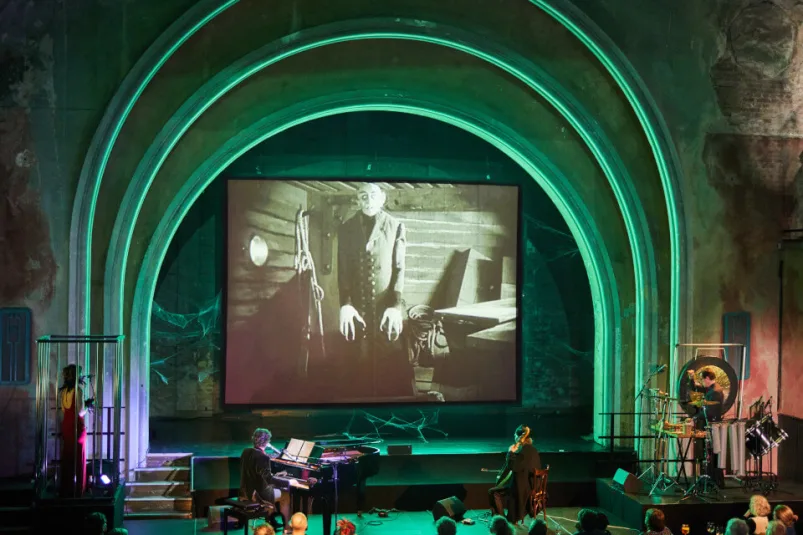Nosferatu: A Symphony of Horror by Murnau (1922)

The Delphi theatre was, for one evening, on the occasion of the silent film festival, the setting for a very nice show: "Nosferatu, eine Symphonie des Grauens". The apparently ordinary cinema opens onto a large, dark, tall room, all dressed in stone and with sepulchral music resounding. From the entrance, an elaborate gothic atmosphere gives the impression of plunging into the catacombs of Nosferatu himself. The count's shadow hovers over the room and lingers on some walls thanks to a play of light and shadow.
Once seated, all that remains is to wait. Silence when the pianist and conductor, Stephan Graf v. Bothmer, enters the stage. Accompanied by an expert team consisting of a soprano, a cellist, a percussionist and a choir of singers, they begin the overture. From the very first notes there are shivers - the pleasure of the music or the anguish caused by Max Schreck - impossible to determine!
Summary of the film
"Nosferatu" is a German silent film made by the great director Murnau in 1922. It is an adaptation of the novel Dracula, written by Brahm Stoker in 1897. Not having obtained the rights for his film, Murnau had to make a few changes: Count Dracula became Count Orlock, for example. It should be noted that the film was the subject of a lawsuit brought by the writer's widow. The judge's decision ordered the destruction of all illegal copies - this judgment was not enforced and several copies circulated as early as the 1930s.
The story takes place in 1838 in the small town of Wisborg, Germany. Thomas Hutter, a young real estate agent, had to travel to a faraway land to get documents signed for the sale of a house in his neighbourhood. After a long journey and despite his coachman's refusal to drive him to his destination, he arrives at the castle of the mysterious Count Orlock. The place, worthy of a horror movie, seems uninhabited and is. The young man begins to harbour certain suspicions about his host, a strange and disturbing character. As night falls, the Count's true evil nature awakens. Feeding night after night on the blood of his guest, he marks him with two characteristic "pimples" on the back of his neck. It is when he sees a miniature of Thomas' wife Ellen that Count Orlock decides to make his way to the city to take possession of his next victim. In his wake, he spreads an epidemic of plague... the nightmare is just beginning!
Film review and opinion
If the film has aged a little and is not as scary as it used to be, it is not to mention the disturbing atmosphere of the shadow play and the atmosphere created by the orchestra with music, noises, whispers and sometimes shouts. The film, which had created so much terror when it was released in theatres, is coming back to life!
Nosferatu's cult character and Murnau's remarkable imagination continue to fascinate today: in 2015, Murnau's head was stolen from his Berlin vault - the trail of occult practices was followed.
The film is based on the charisma of Max Schreck (whose name was predestined since it means "terror" in German) and on his performance so realistic that some viewers wondered whether the mysterious actor was not really a vampire.
To the sinister charm of the vampire is added his terrible powers: Nosferatu can control objects by thought. A real challenge for the time, the film put in place advanced technology using stop-motion photography (putting many pictures in a row to obtain a sequence). If today some scenes are a little smiling, it was one of the first stop-motion animations in the history of cinema.
We highly recommend this experience: a good old classic in an unusual setting with modern staging - these are the ingredients for a successful evening.
Where to see the film Nosferatu with live music?
According to the programme of the Stummfilmfestival which takes place every year in Berlin (www.stummfilmkonzerte.de)
+ the Babylon Kino offers weekly silent films (https://babylonberlin.eu)

Raphaëlle Radermecker
Author
With a curious personality and a passion for well-chosen words, writing and discovery are my two passions. Berlin intrigues and fascinates me, with its cultural and artistic richness, its modernity and its ability to constantly renew itself.